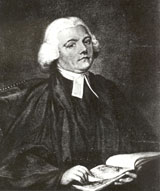|
The Clergyman Naturalist

Gilbert White transformed the way we look at the natural world. He is recognised as one of the fathers of ecology.
Gilbert White, curate at the Hampshire village of Selborne, was one of the first English naturalists to make careful
observations of his surroundings and record these observations in a systematic way. White developed a deep insight into the
inter-relationships of living things. He combined a naturalist's skills with an ability to influence a wider audience through
his writing.
Born in 1720, White was educated in Basingstoke by Thomas Wharton, professor of poetry at Oxford, before going to Oriel
College, Oxford.
White followed his grandfather and uncle into the church. From an early age he took a close interest in the natural world
around him.
White is best known for his Natural History and Antiquities of Selborne (1789). This was a compilation
of letters written to Thomas Pennant and Daines Barrington, both leading naturalists of the day. In the letters, White discussed
his observations and theories about the local fauna and flora in a charming and immediate way. The book is one of the most
published in the English language and it has never been out of print.
An enthusiastic gardener, White grew many flowers, vegetables and fruits at a time when many new kinds were being introduced.
He was thus the first person in the area to grow crops such as potatoes. He experimented, observed
and recorded everything to do with his garden. These interests led him to his insights into natural history.
Most of Gilbert White's contemporaries were convinced that swallows spent the winter hibernating in holes or under the
mud of local ponds. Gilbert White, aware of bird migration, debated this issue with his correspondents and sought evidence
for either the hibernation or migration of swallows, but he never reached a decisive conclusion.
White's original emphasis was on the study of birds . From his pioneering work in bird observation, he
expanded into other areas of natural science.
White primarily believed in studying birds and other creatures in the field . This was an unusual approach
at a time when most naturalists preferred to carry out detailed examinations of dead specimens in their study. White was thus
the first to distinguish the willow wren as three species - chiffchaff, willow warbler and wood warbler - largely on the basis
of their songs. He was the first to accurately describe the harvest mouse and the noctule bat. White spent much time observing
crickets and other small creatures, recognising that all had a role to play. He studied the earthworm and said of it, 'Earthworms,
though in appearance a small and despicable link in the chain of nature, yet, if lost, would make a lamentable chasm. Worms
seem to be the great promoters of vegetation, which would proceed but lamely without them.' (1770)
Gilbert White's journals, which he kept for most of his life (the Garden Kalender 1751-67, the Flora Selborniensis 1766
and the Naturalist's Journal 1768-93) are unique in their detail and the length
of time they span. White meticulously and systematically recorded observations about the weather and about the flora
and fauna of Selborne - even when he was away from home, he arranged for others to continue the recordings so as to maintain
the sequences. His journals abound with evocative quotes, which still today brings his world to life.
'A vast rain. The hay lies about in a miserable way.' (Garden Kalendar, July 29, 1763)
'Ground so
icy that people get frequent falls.' (Journal, Dec. 28, 1783)
'Severe frost, and still sunny fine days. It freezes
even in the kitchen.' (Garden Kalendar, Dec. 30, 1767).
White's brother Benjamin was a publisher of many volumes on natural history. Benjamin introduced Gilbert to Thomas Pennant
(one of the foremost zoologists of the time) and Daines Barrington. Gilbert corresponded with them and other naturalists,
such as Joseph Banks and Daniel Solander. Later, Darwin used White's observations as the basis for some of his own work.
White's writings inspired many other naturalists. His legacy as an accurate and systematic recorder of the natural world
lives to this day.
Gilbert White died in Selborne on 26 June, 1793, he was 72 years of age
|
 |
|
 |
 |
|
![May Fly in the sunset dance [click for larger ]](sitebuildercontent/sitebuilderpictures/.pond/whitemayfly.jpg.w180h237.jpg)
|
|
an article with photograph
at the
the page at the
complete e-text at
Project Gutenberg
and his journey to Selborne
via Findon, in West Sussex
as told by Valerie Martin,
webmistress of
Findon Village.com
|
|
 |
 |
|
 |
|
|
 |
|
|
|

